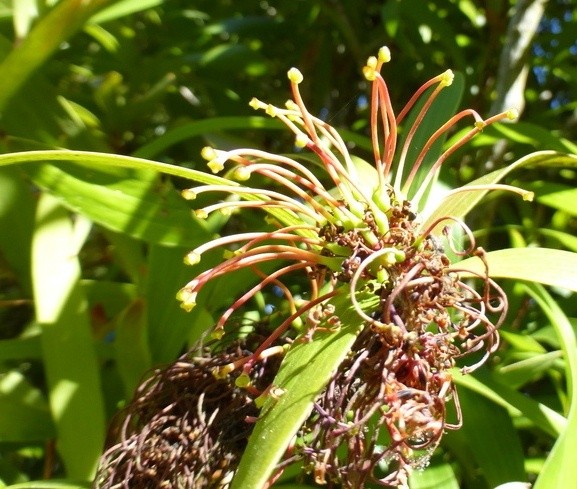Big Nellie hakea
(Hakea archaeoides)

Description
Hakea archaeoides is a large shrub or small tree commonly known as Big Nellie hakea and is endemic to forest areas on the north coast of New South Wales, Australia. It has clusters of red and greenish yellow flowers in the flowering season. Hakea archaeoides is a lignotuberous multi-stemmed shrub growing up to 7 m (20 ft) in height and 4 m (10 ft) in width at maturity. Small branches and young leaves are densely covered in short red-brown silky hairs. The leaf stalk is 0.6–1.5 cm (0.2–0.6 in) long supporting a narrow oval shaped leaf 7.5–28.5 cm (3–10 in) long and 0.6–3 cm (0.2–1 in) wide gradually narrowing to a point 1–3 mm (0.04–0.1 in) long. The inflorescence has 70-110 or more flowers held on a stalk 40–7 mm (2–0.3 in) long generally with densely matted silky hairs. The individual flower stalks are 1.2–2 mm (0.05–0.08 in) long, hairless, reddening with age. The sepals and petals are green and smooth green glabrous or with scattered hairs in bud. The styles are red and 23–27 mm (0.9–1 in) long. Flowers are a red and greenish-yellow and appear in pendant axillary clusters in leaf axils from spring to early summer. The woody fruit are egg-shaped 1.5–2.2 cm (0.6–0.9 in) long and 1.2–1.4 cm (0.5–0.6 in) wide. Hakea archaeoides was first formally described in 1999 by William Barker and published in "Flora of Australia" from a specimen collected near Coopernook. The specific epithet (archaeoides) refers to this species' similarity to primitive hakeas as revealed in cladograms. Hakea archaeoides is restricted to Taree and Wauchope areas in north-eastern New South Wales growing in wet sclerophyll forest and rainforest on hill slopes. Plants in the genus Hakea are shrubs or small trees. Some species have flat leaves, whilst others have leaves which are needle-like, in which case they are sometimes divided and sometimes have a groove on the lower surface. The flowers are arranged in groups in leaf axils and are surrounded by bracts when in bud. The flowers have both male and female parts and are borne on a short stalk called a pedicel. The sepals and petals, jointly called tepals, form a curved tube which sometimes splits open as the flower develops. The style is longer than the tepal tube and is curved before its tip is released. When released, the tip of the style is a pollen-presenter. The fruit of hakeas is woody and persists on the plant until burned in a bushfire or until the plant dies. The fruit then splits open to release two winged seeds.
Taxonomic tree:







